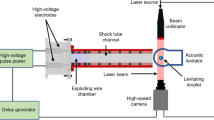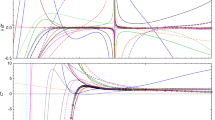Abstract
Flow instability in three entangled polymer systems including a 10 wt% 1,4-polybutadiene (PBD) solution, an 11.4 wt% polyisobutylene (PIB) solution, and a long chain branched polyethylene melt (LD 146) was investigated in both stress-controlled and rate-controlled experiments in the cone–plate geometry. It was found that flow instability occurred for experiments in both rate- and stress-controlled modes. The effects of cone angle or rim gap and shearing time on flow instability were studied. The smaller cone angle and shorter shearing time delay (in terms of stress or shear rate) the occurrence of severe instability and mass loss of the PBD solution but not for the PIB. Our data are consistent with the dramatic shear rate jump for the flow curve constructed from the stress-controlled experiments being associated with mass loss after the severe instabilities. We also find that the Cox–Merz representation gives a powerful tool for investigation of flow instability. Finally, another interesting result in this work is that it seems that the stress overshoot can be related to the onset of flow instability in the present system.


















Similar content being viewed by others
References
Al-Hadithi TSR, Barnes HA, Walters K (1992) The relationship between the linear (oscillatory) and nonlinear (steady-state) flow properties of a series of polymer and colloidal systems. Colloid Polym Sci 270:40–46
Archer LA, Sanchez-Reyes J, Juliani J (2002) Relaxation dynamics of polymer liquids in nonlinear step strain. Macromolecules 35:10216–10224
Bird RB, Armstrong RC, Hassager O (1977) Dynamics of polymeric liquids. Willey, New York, p 154
Crawley RL, Graessley WW (1977) Geometry effects on stress transient data obtained by cone and plate flow. Trans Soc Rheol 21:19–49
Cox WP, Merz EH (1958) Correlation of dynamic and steady state flow viscosities. J Polym Sci 28:619–622
Ferri D, Lomellini P (1999) Melt rheology of randomly branched polystyrenes. J Rheol 43:1355–1372
Ferry JD (1980) Viscoelastic properties of polymers. Willey, New York, p 523
Fukuda M, Osaki K, Kurata M (1975) Nonlinear viscoelasticity of polystyrene solutions I. J Polym Sci Polym Phys Ed 13:1563–1567
Gleissle W, Hoshestein B (2003) Validity of the Cox–Merz rule for concentrated suspensions. J Rheol 47:897–910
Graessley WW (1974) The entanglement concept in polymer rheology. Adv Polym Sci 16:1–179
Huilgol RR, Pinazza M, Payen LE (1993) On the rectangular flow of a second-order fluid and the role of second normal stress difference in edge fracture in rheometer. J Non-Newton Fluid Mech 50:331–348
Huilgol RR, Pinazza M, Payen LE (1994) Corrigenda. J Non-Newton Fluid Mech 55:209–211
Hutton JF (1963) Fracture of liquids in shear. Nature 200:646–648
Hutton JF (1965) The fracture of liquids in shear: the effects of size and shape. Proc R Soc Lond Ser A 287:222
Hutton JF (1969) Fracture and secondary flow of elastic liquids. Rheol Acta 8:54–59
Inn YW, Wissbrun KF, Denn MM (2005) Effect of edge fracture on constant torque rheometry of entangled polymer solutions. Macromolecules 38:9385–9388
Keentok M, Xue S-C (1999) Edge fracture in cone–plate and parallel plate flows. Rheol Acta 38:321–348
Kocherov VL, Lukach YL, Sporyagin EA, Vinogradov GV (1973) Flow of polymer melts in a disc-type extruder and rotational devices of the ‘cone–plate’ and ‘parallel-plate’ type. Polym Eng Sci 13:194–201
Kulicke WM, Porter RS (1979) Irregularities in steady flow for non-Newtonian fluids between cone and plate. J Appl Polym Sci 23:953–965
Kulicke WM, Porter RS (1980) Relation between steady shear flow and dynamic rheology. Rheol Acta 19:601–605
Kulicke WM, Wallbaum U (1985) Determination of first and second normal stress differences in polymer solutions in steady shear flow and limitations caused by flow irregularities. Chem Eng Sci 40:961–972
Kulicke WM, Jeberien HE, Kiss H, Porter RS (1979) Visual observation of flow irregularities in polymer solutions at theta-conditions. Rheol Acta 18:711–716
Larson RG (1992) Instabilities in viscoelastic flows. Rheol Acta 31:213–263
Larson RG, Khan SA, Raju VR (1988) Relaxation of stress and birefringence in polymers of high molecular weight. J Rheol 32:145–161
Lee CS, Tripp BC, Magda JJ (1992) Does N 1 or N 2 control the onset of edge fracture. Rheol Acta 31:306–308
Macosko CW (1994) Rheology: principles, measurements, and applications. VCH, New York
Magda JJ, Larson RG (1988) A transition occurring in ideal elastic liquids during shear-flow. J Non-Newton Fluid Mech 30:1–19
Marrucci G (1983) The free energy function of the Doi and Edwards theory: analysis of the instability in stress relaxation. J Rheol 27:433–450
Marrucci G (1996) Dynamics of entanglements: a nonlinear model consistent with the Cox–Merz rule. J Non-Newton Fluid Mech 62:279–289
McKinley GH, Byars JA, Brown RA, Armstrong RC (1991) Observations in elastic instability in cone–plate and parallel-plate flows of polyisobutylene Boger fluid. J Non-Newton Fluid Mech 40:201–229
McKinley GH, Oztekin A, Byars JA, Brown RA (1995) Self-similar spiral instabilities in elastic flows between a cone and plate. J Fluid Mech 285:123–164
Mead DW, Larson RG (1990) Rheooptical study of isotropic solutions of stiff polymers. Macromolecules 23:2524–2533
Menezes EV, Graessley WW (1982) Non-linear rheological behavior of polymer systems for several shear-flow histories. J Polym Sci Polym Phys Ed 20:1817–1833
Mhetar V, Archer LA (1999) Nonlinear viscoelasticity of entangled polymeric liquids. J Non-Newton Fluid Mech 81:71–81
Olagunju DO, Cook LP (1993) Linear stability analysis of cone-and-plate flow of an oldroyd-B fluid. J Non-Newton Fluid Mech 47:93–105
Osaki K, Fukuda M, Ohta S, Kim BS, Kurata M (1975) Nonlinear viscoelasticity of polystyrene solutions. II. Non-Newtonian viscosity. J Polym Sci Polym Phys Ed 13:1577–1589
Osaki K, Inoue T, Isomura T (2000a) Stress overshoot of polymers at high rates of shear. J Polym Sci Polym Phys Ed 38:1917–1925
Osaki K, Inoue T, Isomura T (2000b) Stress overshoot of polymers at high rates of shear: polystyrene with bimodal molecular weigh distribution. J Polym Sci Polym Phys Ed 38:2043–2050
Osaki K, Inoue T, Uematsu T (2000c) Stress overshoot of polymers at high rates of shear: semidilute polystyrene solutions with and without chain entanglement. J Polym Sci Polym Phys Ed 38:3271–3276
Pattamaprom C, Larson RG (2001) Constraint release effects in monodiesperse and bidisperse polystyrenes in fast transient shearing flows. Macromolecules 34:5229–5237
Pearson DS, Rochefort WE (1982) Behavior of concentrated polystyrene solutions in large-amplitude oscillating shear fields. J Polym Sci Polym Phys Ed 20:83–98
Pearson DS, Herbolzheimer E, Grizzuti N, Marrucci G (1991) Transient behavior of entangled polymers at high shear rates. J Polym Sci B Polym Pyhs Ed 29:1589–1597
Phan-Thien N (1985) Cone and plate flow of Oidroyd-B fluid is unstable. J Non-Newton Fluid Mech 17:37–44
Rosen SL (1993) Fundamental principles of polymeric materials. Wiley, New York
Sanchez-Reyes J, Islam MT, Archer LA (2002) Step shear dynamics of highly entangled polymer liquids. Macromolecules 35:5194–5202
Sui C, McKenna GB, ANTEC 2006 (2006) Proceedings of the 64th Annual Technical Conference & Exhibition, Charlotte, NC. May 7–11. Soc Plast Eng, pp. 2351–2355
Sui C, McKenna GB (2007) Nonlinear viscoelastic properties of branched polyethylene in reversing flows. J Rheol (in press)
Tanner RI, Keentok M (1983) Shear fracture in cone–plate rheometry. J Rheol 27:47–57
Tapadia P, Wang S-Q (2003) Yieldlike constitutive transition in shear flow of entangled polymeric fluids. Phys Rev Lett 91:198301–198304
Tapadia P, Wang S-Q (2004) Nonlinear flow behavior of entangled polymer solutions: yieldlike entanglement-disentanglement transition. Macromolecules 37:9083–9095
Tapadia P, Wang S-Q (2006) Direct visualization of continuous simple shear in non-Newtonian polymeric fluids. Phys Rev Lett 96:016001–016004
Venerus DC, Ritesh N (2006) Stress relaxation dynamics of an entangled polystyrene solution following step strain flow. J Rheol 50:59–75
Wang S-Q, Ravindranath S, Boukany PE, Olechnowicz M, Quirk RP, Halasa A, Mays J (2006) Non-quiescent relaxation in entangled polymeric liquids after step shear. Phys Rev Lett 97:187801–187804
Wen YH, Lin HC, Li CH, Hua CC (2004) An experimental appraisal of the Cox–Merz rule and Laun’s rule based on bidisperse entangled polystyrene solutions. Polymer 45:8551–8559
Acknowledgment
Thanks to the American Chemical Society–Petroleum Research Fund under Grant 40615-AC7 and the J.R. Bradford endowment at Texas Tech University for partial support of this work. The authors also thank S-Q Wang and A. Philips for highly fruitful discussions.
Author information
Authors and Affiliations
Corresponding author
Rights and permissions
About this article
Cite this article
Sui, C., McKenna, G.B. Instability of entangled polymers in cone and plate rheometry. Rheol Acta 46, 877–888 (2007). https://doi.org/10.1007/s00397-007-0169-8
Received:
Accepted:
Published:
Issue Date:
DOI: https://doi.org/10.1007/s00397-007-0169-8




